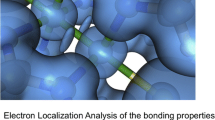Abstract
We study the electronic structure of two types of transition metal complexes, the inverted-sandwich-type and open-lantern-type, by the electronic stress tensor. In particular, the bond order \(b_\varepsilon\) measured by the energy density which is defined from the electronic stress tensor is studied and compared with the conventional MO-based bond order. We also examine the patterns found in the largest eigenvalue of the stress tensor and corresponding eigenvector field, the “spindle structure” and “pseudo-spindle structure”. As for the inverted-sandwich-type complex, our bond order \(b_\varepsilon\) calculation shows that relative strength of the metal-benzene bond among V, Cr, and Mn complexes is V > Cr > Mn, which is consistent with the MO-based bond order. As for the open-lantern-type complex, we find that our energy density-based bond order can properly describe the relative strength of Cr–Cr and Mo–Mo bonds by the surface integration of the energy density over the “Lagrange surface” which can take into account the spatial extent of the orbitals.















Similar content being viewed by others
Notes
They are called M1 and Mo1 in Ref. [29].
If calculated at the cc-pVDZ level, we see small regions with positive eigenvalue just like those of the Mo–Mo bond in Fig. 14. Since such regions do not appear at 6-31G(d,p), cc-pVTZ and cc-pVQZ levels, we believe they are numerical artifacts in the case of C2H2.
References
Schrödinger E (1927) Ann Phys (Leipzig) 82:265
Pauli W, der Physik Handbuch (1933) Band XXIV, Teil 1, Springer, Berlin, pp 83–272; reprinted in Handbuch der Physik, vol 5, Springer, Berlin, 1958 (Part 1); translated into English in General Principles of Quantum Mechanics, Berlin, Springer, 1980
Epstein ST (1975) J Chem Phys 63:3573
Bader RFW (1980) J Chem Phys 73:2871
Bamzai AS, Deb BM (1981) Rev Mod Phys 53:95
Nielsen OH, Martin RM (1983) Phys Rev Lett 50:697
Nielsen OH, Martin RM (1985) Phys Rev B 32:3780
Folland NO (1986) Phys Rev B 34:8296
Folland NO (1986) Phys Rev B 34:8305
Godfrey MJ (1988) Phys Rev B 37:10176
Filippetti A, Fiorentini V (2000) Phys Rev B 61:8433
Tachibana A (2001) J Chem Phys 115:3497
Pendás AM (2002) J Chem Phys 117:965
Rogers CL, Rappe AM (2002) Phys Rev B 65:224117
Tachibana A (2004) Int J Quantum Chem 100:981
Tachibana A (2005) J Mol Model 11:301
Morante S, Rossi GC, Testa M (2006) J Chem Phys 125:034101
Tao J, Vignale G, Tokatly IV (2008) Phys Rev Lett 100:206405
Ayers PW, Jenkins S (2009) J Chem Phys 130:154104
Tachibana A (2010) J Mol Struct (THEOCHEM) 943:138
Szarek P, Tachibana A (2007) J Mol Model 13:651
Szarek P, Sueda Y, Tachibana A (2008) J Chem Phys 129:094102
Szarek P, Urakami K, Zhou C, Cheng H, Tachibana A (2009) J Chem Phys 130:084111
Ichikawa K, Myoraku T, Fukushima A, Ishihara Y, Isaki R, Takeguchi T, Tachibana A (2009) J Mol Struct (THEOCHEM) 915:1
Ichikawa K, Tachibana A (2009) Phys Rev A 80:062507
Ichikawa K, Wagatsuma A, Kusumoto M, Tachibana A (2010) J Mol Struct (THEOCHEM) 951:49
Ichikawa K, Ikeda Y, Wagatsuma A, Watanabe K, Szarek P, Tachibana A (2011) Int J Quant Chem (in press)
Kurokawa YI, Nakao Y, Sakaki S (2010) J Phys Chem A 114:1191
Kurokawa YI, Nakao Y, Sakaki S (2009) J Phys Chem A 113:3202
Ayers PW, Parr RG, Nagy A (2002) Int J Quant Chem 90:309
Anderson JSM, Ayers PW, Hernandez JIR (2010) J Phys Chem A 114:8884
Senami M, Ichikawa K, Doi K, Szarek P, Nakamura K, Tachibana A (2008) Molecular regional DFT program package, ver. 3. Tachibana Lab, Kyoto University, Kyoto
Schmidt MW, Baldridge KK, Boatz JA, Elbert ST, Gordon MS, Jensen JH, Koseki S, Matsunaga N, Nguyen KA, Su S, Windus TL, Dupuis M, Montgomery JA (1993) J Comput Chem 14:1347
Bergner A, Dolg M, Kuechle W, Stoll H, Preuss H (1993) Mol Phys 80:1431
Dolg M, Wedig U, Stoll H, Preuss H (1987) J Phys Chem 86:866
Dunning TH Jr (1989) J Chem Phys 90:1007
DeLano WL (2008) The PyMOL molecular graphics system. DeLano Scientific LLC, Palo Alto. http://www.pymol.org
Varetto U (2009) MOLEKEL Version 5.4; Swiss National Supercomputing Centre: Manno (Switzerland)
Tsai YC, Wang PY, Chen SA, Chen JM (2007) J Am Chem Soc 129:8066
Tsai YC, Wang PY, Lin KM, Chen SA, Chen JM (2008) Chem Commun 205
Monillas WH, Yap GPA, Theopold KH (2007) Angew Chem Int Ed 46:6692
Frenking G, Fröhlich N (2000) Chem Rev 100:717
Acknowledgments
Theoretical calculations were partly carried out using Research Center for Computational Science, Okazaki, Japan. This research work is supported partly by Collaborative Research Program for Young Scientists of ACCMS and IIMC from Kyoto University. This work is supported partly by Grant-in-Aid for Scientific research (No. 22550011), Grant-in-Aid for Specially Promoted Research (No. 22000009), and Grand Challenge Project (IMS, Okazaki, Japan) from the Ministry of Education, Culture, Sports, Science and Technology, Japan.
Author information
Authors and Affiliations
Corresponding author
Additional information
Dedicated to Professor Shigeru Nagase on the occasion of his 65th birthday and published as part of the Nagase Festschrift Issue.
Rights and permissions
About this article
Cite this article
Ichikawa, K., Wagatsuma, A., Kurokawa, Y.I. et al. Inverted-sandwich-type and open-lantern-type dinuclear transition metal complexes: theoretical study of chemical bonds by electronic stress tensor. Theor Chem Acc 130, 237–250 (2011). https://doi.org/10.1007/s00214-011-0966-0
Received:
Accepted:
Published:
Issue Date:
DOI: https://doi.org/10.1007/s00214-011-0966-0




